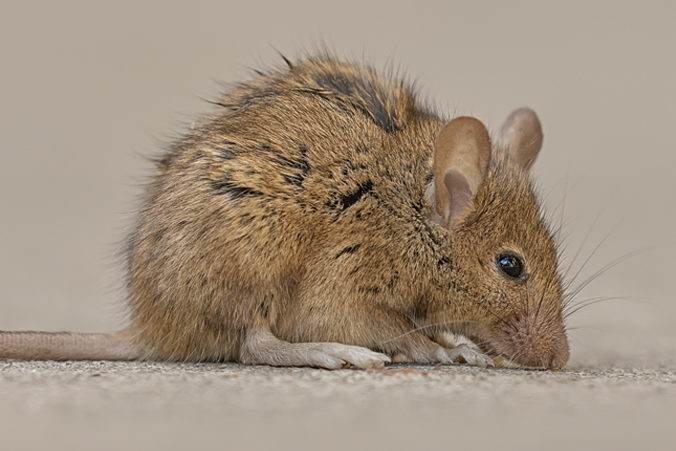by Justin Metz on August 3, 2020
Gnawed wires. Damaged upholstery. Foul odors. These are all telltale signs that you may have a mouse taking up residence in your car.
While mice may be small, they can create big problems for you and your vehicle. A single mouse can cause thousands of dollars in damage to your car in a matter of days. And the diseases they carry can be harmful to your health, too.
If you suspect a mouse has made your car its new home, the best course of action is to get it out — fast. Keep reading to find out tips to help you track down any unwanted rodent passengers and keep them out for good – and learn how your car insurance can help if something goes wrong.
HOW DO I KNOW IF A MOUSE IS LIVING IN MY CAR?
There are several ways you can tell if a mouse is living in your vehicle:
- Car problems: Unfortunately, some drivers first discover a rodent problem after their car won’t start or isn’t working properly. This is often caused by mice chewing through wires in the engine compartment. A mouse or rat will gnaw on wires as a means to sharpen its teeth. And there is some evidence that mice find newer soy-based wire insulation materials to be pretty tasty, too. With so many complex electrical systems in modern cars, chewed up wires are almost guaranteed to cause problems.
- Damaged upholstery: If a mouse has decided to make itself a new home in your car, it will start by looking for materials to build a nest. Lucky for that mouse… plenty of things in your car could work perfectly. If you find holes in your seats, missing chunks of insulation or chewed-up foam, you might have a mouse problem.
- Mouse droppings: Like any pest infestation, finding animal waste is a pretty good indicator that you have a problem. Look for tiny mouse droppings on your car’s carpeting, seat and dashboard.
- Bad smells: If you detect foul odors coming from your car, it may be due to a pest problem. Often, drivers will first detect these smells coming from the vehicle’s air vents. Mice can use the vent system as a tunnel to get from the engine bay to your car’s interior. And vents often provide easy access to insulation and filter materials they can use to build a nest. Over time, a musty odor can develop from mouse urine (gross, we know). And if the smell is really bad, there’s a chance the rodent may have died inside.
- Mouse nest: Finding a mouse nest is the easiest way to confirm your rodent suspicions. The first place you should look is inside your car’s airbox (that’s where the engine air filter is located). Mice love this location because it’s warm and protected from the elements. Open the box and look for signs of rodent freeloaders. The area should be empty and relatively clean, so it will be evident if there’s a nest inside. You should also check under your car’s plastic engine cover, if it has one.
WHY DO MICE NEST IN A CAR?
If you suspect mice are living in your car, they’ve moved in for one or more of the following reasons:
- Shelter: When looking for a home, mice make safety a top priority. Your car provides protection from predators and the elements. And if it hasn’t been driven in a while, it becomes even more desirable. (Read our list of tips of how to keep your car safe when you’re not driving it.)
- Food: Mice also look for places to nest that are close to a food source. This could be a factor if you store pet food in the garage or park outside near your building’s dumpster. If you have a habit of leaving food, crumbs or trash inside the car, the mouse is sure to stick around.
- Warmth: This is a factor in the winter months. After driving your car, the engine will radiate heat for hours — making it the perfect place for rodents to escape the cold.
HOW DOES A MOUSE GET INSIDE MY CAR?
Even if you leave your doors closed and your windows rolled up, there are plenty of ways for a mouse to gain entry into your car. In the engine compartment, the air inlet provides a direct path to the airbox, where mice love to nest. And from the engine compartment, a mouse can squeeze into the interior of your car through a vent or holes designed for wires, cables, pedals or your steering column.
WHAT TYPE OF DAMAGE CAN A MOUSE CAUSE?
A determined mouse or rat can chew through all kinds of materials — including plastic and metal. This means they can cause significant damage to your vehicle.
The most substantial problems are caused when a mouse chews through wires. And the extent of the damage will largely depend on which wires the rodent decides to gnaw. For example, a chewed-up main wire harness or engine control module could cost thousands of dollars to repair.
But the problems don’t stop there. If a mouse gets inside your car’s vent system, the dash area may need to be disassembled for a thorough cleaning. Because breathing in those musty odors is bad for your nose — and your health.
HOW DO I GET A MOUSE OUT OF MY CAR?
Here are a few ways to encourage the mouse to find a new home.
- Turn up the heat. Just like humans, mice don’t like extreme temperatures. Roll up your car’s windows and park in the sun for a few hours. All that heat may convince the mouse to move out.
- Honk the horn. Loud noises, like honking your horn, may scare a mouse of its new home in your car. Just expect some strange looks from the neighbors.
- Use repellent. Most home improvement stores will sell several types of mouse repellents you can place in and around your car. Many people have also had success using cotton balls soaked in peppermint oil.
- Set mousetraps. Mousetraps aren’t only useful for keeping mice out of your house. Setting traps in or under your vehicle can also help protect your vehicle from unwanted visitors.
HOW DO I PREVENT MICE FROM LIVING IN MY CAR?
Once you evict the mouse from your car, follow these tips to keep it from returning.
- Park in the garage. Cars left outside will be more susceptible to rodent intruders. So park inside, if possible. And be sure to close your doors, windows and sunroof.
- Keep it moving. The best way to keep mice out is through regular use of your car. Vehicles that sit for long periods of time without moving will make for a more inviting home.
- Clean your car. A car filled with trash and food crumbs is a welcome invitation for mice. Keep the inside of your car clean and regularly remove any leaves or debris from the engine bay, too. Read more about how to clean and detail your car at home.
- Don’t park near a food source. Try to park your car away from food sources like garbage containers or bird feeders. And keep any food stored in your garage, including pet food, in sealed containers.
IS RODENT DAMAGE TO MY CAR COVERED BY MY AUTO INSURANCE?
If you’re an Erie Insurance customer, animal-related damage to your car is covered by the optional comprehensive coverage in your auto insurance policy. That includes damage to your car from mice or rats. You’ll just be responsible for paying your deductible.
Questions about your specific policy? Talk to your local ERIE agent to understand what your policy can cover (and where you might have gaps).
LOOKING AFTER YOU
There are enough surprises in life. Insurance coverage shouldn’t be one of them. That’s why we’re here to provide insurance that comforts and protects.






